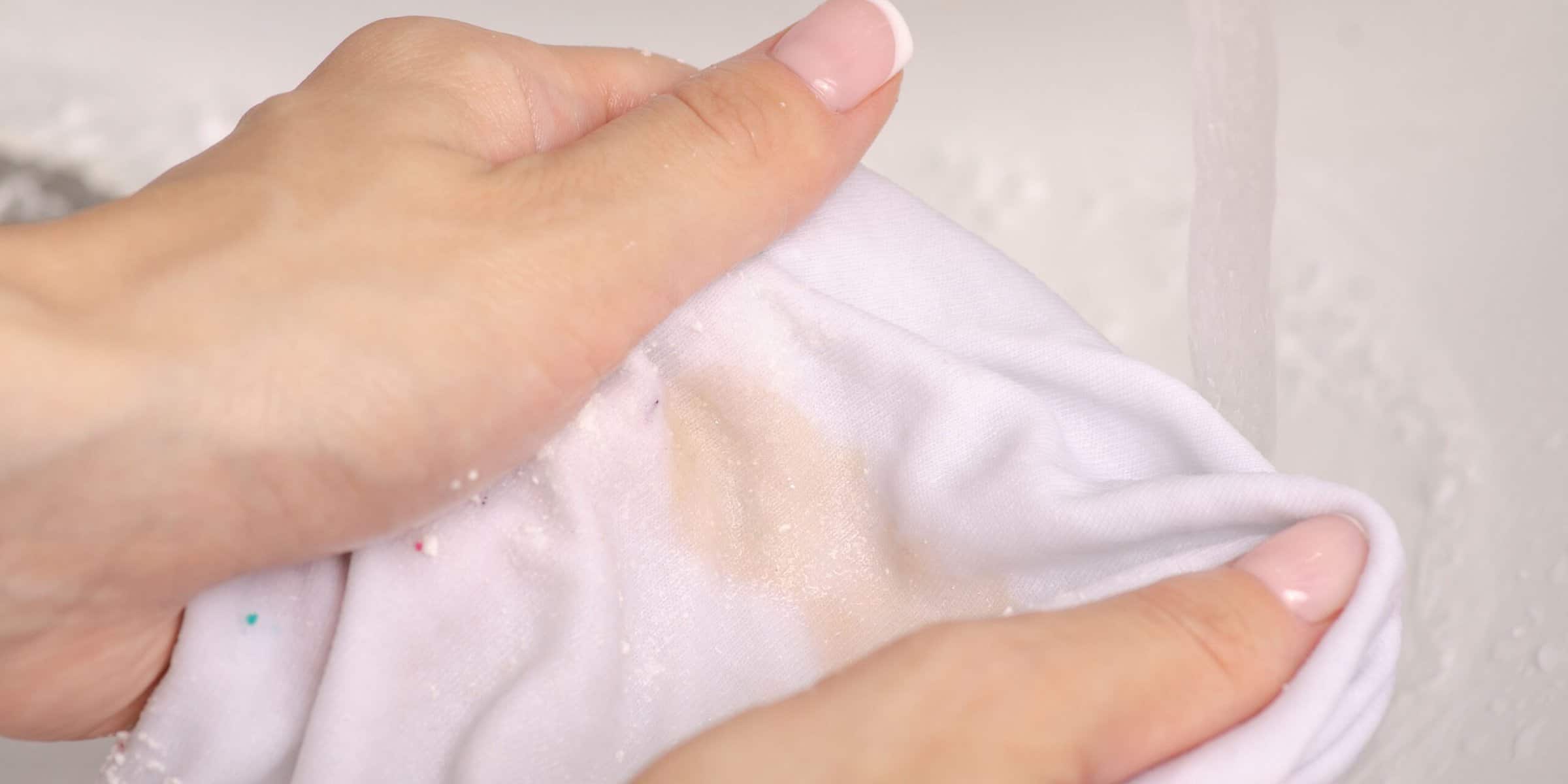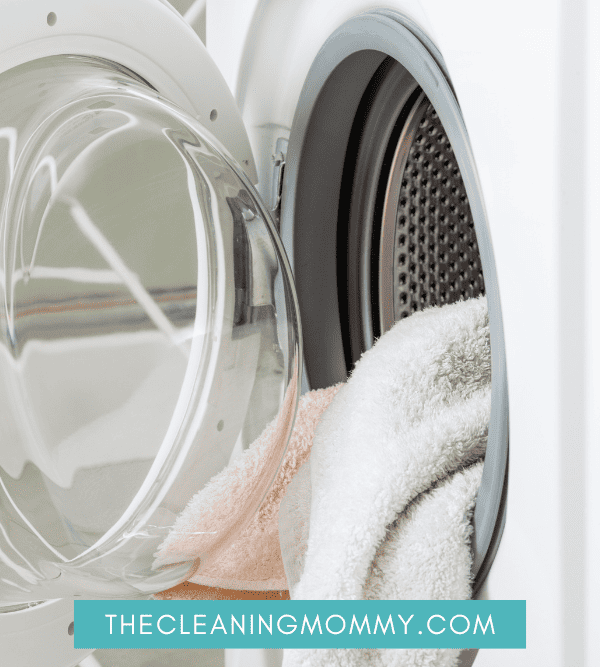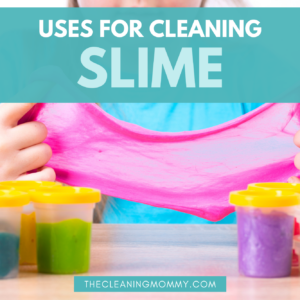Washing your bedding should be a weekly task, but when it comes to luxurious comforters that cannot be thrown into the washing machine, you might just need to care for them with simple spot cleaning. If you are wondering how to spot clean a comforter you have come to the right place.
You should wash a large comforter 3-4 times per year, or to make it simple, just wash it when a new season comes into play.
Here are a few explanations on how to effectively spot-clean a comforter, as well as information on dry cleaning and deep cleaning. After you’ve had a better night’s sleep, you’ll thank me!
How To Spot Clean A Comforter
Here are the 5 steps to spot cleaning a comforter:
- Move the filling away from the stain.
- Prepare the cleaning solution of your choice
- Rub the spot treatment into the stain
- Rinse thoroughly
- Air dry the comforter and repeat if necessary

How To Quickly Spot Clean A Comforter
If you have a small greasy smear, makeup mark, or bloodstain on your comforter, you might want to consider giving it a fast and easy stain removal instead of a detailed full-on wash. Lets take a look at these steps in more detail.
- The first thing we’ll want to do is get all the filling of the comforter away from the area where we’ll be treating. This ensures that we’ll not potentially damage the filling and take away the fluffiness of your luxurious comforter.
- Get your cleaning solution of choice. I like to use a baking soda and water paste, or a white vinegar and water solution for tougher stains. You can also use a commercial stain remover like Oxi Clean, BuggyLove Organic Stain Remover, or Arm and Hammer Washing Soda. The only thing you should not use is bleach.
- Work the cleaning solution into the stain. Blot the stain with your cleaning solution of choice with a white cloth. Rub the fabric together if the stain is stubborn. Make sure your solution is evenly distributed across the entire stain.
- Once the stain is showing signs of coming clean, then you can rinse that spot off with some cool water. Make sure to squeeze out any excess water and blot the area with a cloth to dry up any remaining moisture to the best of your ability.
- Air drying is the preferred way to dry your comforter. Heat drying will set in any left over stain where air drying will allow you to check, and repeat the process if necessary. Enjoy better sleep with a clean comforter free of icky stains!
Washing the Whole Comforter
If the need is more for a full wash than a spot clean, there are several methods you can use to clean the whole comforter.

How To Wash A Comforter In The Washing Machine
If you have a front-loading washer and dryer that can handle your comforter, you might be able to accomplish the task of machine washing a comforter right at home. If you have a king size bed, you may not be able to accomplish this.
First, make sure you have adequate room in your washing machine to wash your comforter.
Check the label and look for specific care instructions. In most cases, you can wash a comforter with mild detergent and cold or warm water. If your comforter says dry clean only, then well wash it at your own risk.
Bedding can get expensive, so if you need to head to the dry cleaners, then do so instead of risking damage during the washing process and drying process. Harsh chemicals can be damaging to some materials, even with down alternative comforters.
To wash a comforter (or comforter cover) at home, load it up into the washing machine and add a small amount of mild detergent as you normally would.
Set your washer to the bulky setting and choose the temperature that the care label suggests. I would recommend a cold wash if you do not have a care label to refer to. This is the best bet to avoid damage during the washing and drying process. But if the label says it’s ok, you can use warm water.
You’ll likely want to use the gentle or delicate cycle, especially for comforters. Ensure that you set the washer to program an extra rinse cycle to ensure that all the detergent is washed away and there is no residue left over.
After you have completed a wash cycle, load it into the dryer for the drying cycle.
Use a low heat setting for down comforters and an auto-dry function. You can add in some dryer balls, clean tennis balls, or aluminum foil to prevent the filling from clumping up into a ball. Tennis balls are cheap and work great!
Turn on the dryer and check on the comforter every half hour to ensure it isn’t clumping. If it is, readjust the comforter and your wool dryer balls (or add a few tennis balls if you don’t have enough). Keep drying the down comforter until is completely dry.
If your comforter is slightly damp, then you might need to hang it to dry before placing it back onto the bed. A drying rack is especially helpful to have in these kinds of situations and will save a few hours of drying time on your electrical bill.
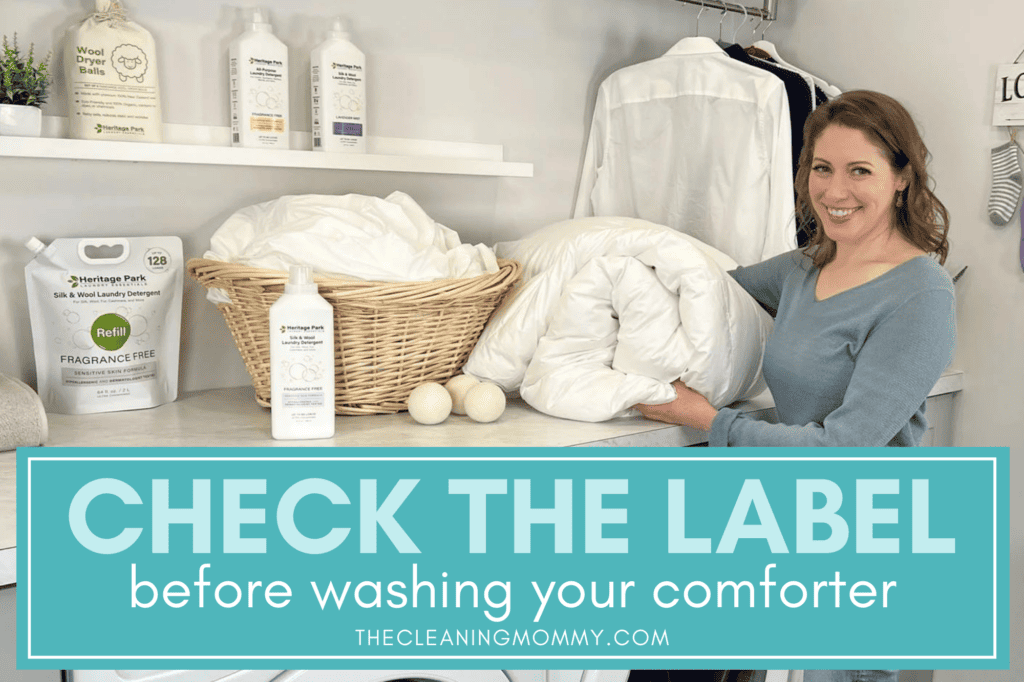
Washing A Down Comforter By Hand
If you do not have a larger capacity washing machine, hand washing may be the right move. To hand wash a large comforter, you should use your bathtub for a deep clean. Again, check the care instructions!
- Fill the tub with cold water and add in your laundry detergent before you place your comforter inside the water.
- Mix the detergent into the water by swirling it around with your hand.
- Place the entire comforter into the water and submerge it fully in the bathtub. Make sure the comforter is evenly distributed and you have enough room to cover it with cold water.
- Do not wring out any water as this could damage the filling.
To wash the comforter in the bathtub, you’ll want to press the comforter gently with your hands and let the water and detergent penetrate the comforter.
- Let the comforter soak for 10-15 minutes. This is a good time to check for loose threads!
- Let the water and laundry detergent out of the tub and press down on the comforter to drain excess water, without wringing it out.
- Fill the tub with cold water once more to get any excess detergent out of the comforter.
You can also use a handheld showerhead to wash off any remaining soap from the comforter.
- Keep washing the detergent out until you see the water run clear of suds.
- Drain the bathtub and hang the comforter to dry in the sunshine or in the bathroom.
If you have a dryer that can accommodate your comforter, place your comforter into the dryer and use the air dry or gentle cycle to dry it out.
Before you place the clean comforter back onto the bed, ensure that it is fully dry.
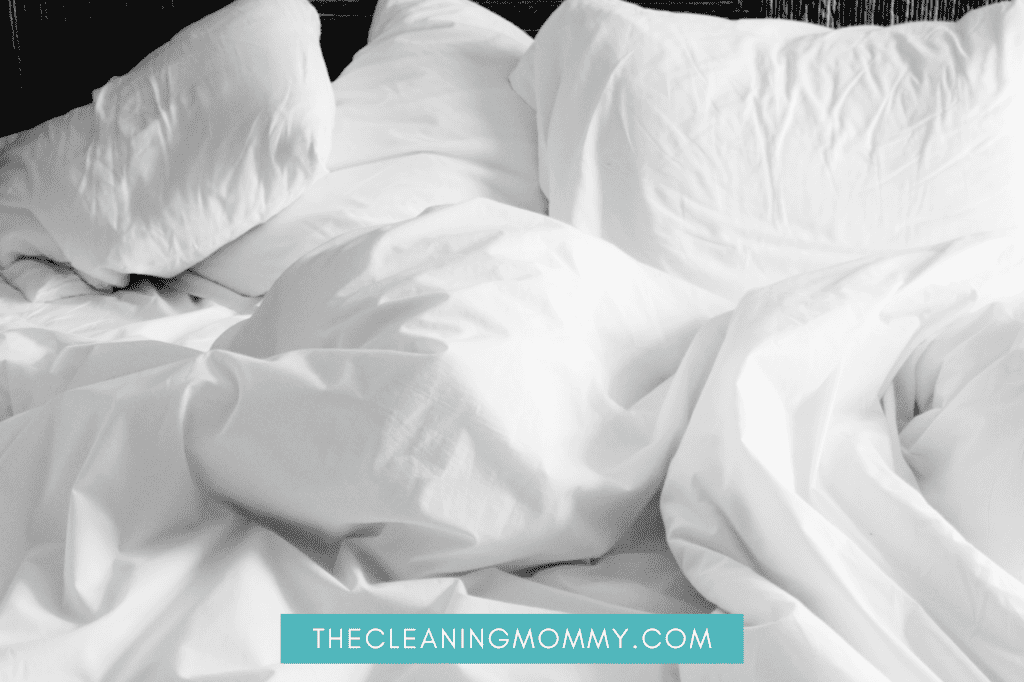
Dry Clean Only Comforters
If your comforter states that it is to be dry cleaned only, please follow that advice and head to your dry cleaner to get your comforter cleaned via a dry cleaning process. It is possible to damage your comforter by washing it in your own washing machine otherwise, and even more so with harsh chemicals.
Allergies Caused By Dirty Bedding
Eczema sufferers may experience rashes if dead skin cells are present on their skin. There is also the possibility that bacteria can cause folliculitis, a painful infection that causes itchy skin and acne-like breakouts anywhere except the feet and palms. Over-the-counter drugs or prescription antibiotics may be required in some cases of folliculitis breakouts.
Those dead skin cells will also attract dust mites. These tiny critters can also cause allergic reactions in some people with sensitive skin.
Your pet is a wonderful companion, but it’s not a good idea to invite him or her into your bed at night. You may contract parasites and fungal organisms from animals, such as ringworm and scabies.
Sheet washing frequency isn’t a set rule. Weekly washing of sheets and pillowcases is recommended.
Although there are a few exceptions, keep in mind that they are not all applicable. To get rid of extra germs, you may need to wash your sheets and pillowcases more often when you’re sick or sweat a lot during the night.
Use warm or hot water to wash your sheets and pillowcases (always check the fabric care instructions before using any temperature of water) to get rid of germs, and tumble dry on low to dry them. Sanitizing settings in washers and dryers may also be useful. You should always make your bed with completely dry sheets before storing them away or storing them, to prevent mildew.
Only a few washings a year are required for pillows, comforters, and blankets. For optimum shape and durability, put them through a delicate cycle and rinse them several times to remove all soap. It may be necessary to fluff heavy or thick blankets and comforters and pillows several times during the drying cycle in order for them to dry evenly.

Frequently Asked Questions About Cleaning Comforters
Can I Use Bleach On Regular Sheets?
The whitening power of bleach is well known. Even accidentally spilling bleach on colored fabrics can whiten them. Whitening your sheets with bleach actually has the reverse effect than you might expect.
Chlorine is contained in bleach. A chemical reaction occurs between chlorine and proteins in sweat and body oil, resulting in yellow spots.
You should first wash your bed sheets with your regular laundry detergent before using bleach to whiten them. Sweat and body oils are removed by washing. Then run a regular wash cycle and add half a cup of bleach to the drum.
Natural bleaching agents like citric acid are found in lemons. For whiter sheets, add lemon juice to your regular detergent in your washing machine. You can also neutralize the lingering vinegar smell by presoaking your sheets in vinegar.
Natural whitening properties are also found in baking soda, a natural odor neutralizer. Baking soda can be added to regular laundry detergent to ensure sparkling white sheets. Detergents are more effective when they are boosted with this. Your bed sheets will be white and odor-free.
Make your sheets last longer by presoaking them in vinegar. Pour a half cup of vinegar into a tub or a big bucket with warm water. Let the sheets soak for an hour in the solution. Wash it with a gentle detergent in the machine or by hand. Any vinegar smell will fade away when you dry your sheets.
An inexpensive whitening laundry booster, borax is a white powdery mineral found in any grocery store. You can presoak your sheets in Borax-water solution overnight by adding half a cup to one gallon of water. Use a mild detergent to wash them. The yellow tinge on your white bed sheets can be removed with a whitening laundry booster.
Where Can I Take The Comforter To Be Washed
If your comforter is simply too large for your washing machine, you can find a local laundromat with large machines for washing and drying. Cleaning the comforter at the local laundromat is much simpler than washing the comforter by hand in the bathtub. If you choose this option, ensure that you are using the delicate cycle in the washer and the dryer.
How Often Should I Wash The Comforter?
You should be washing your comforter once every 4 months, or every quarter of the year at the very least. If you do not use a top sheet and your comforter comes into direct contact with your skin, then you should be washing it likely with your other pillowcases and bedsheets with a mild detergent.

Why Does My Comforter Smell
According to this medical professional source, dust mites and bacteria build up in the comforter over time and this can cause it to start smelling. The comforter can absorb excess moisture from your body, which is more common if you do not use a top sheet while you sleep. If your comforter is starting to smell, this is a sign that it needs to be washed. You’ll want to kill dust mites in any case, because that’s just gross.
Putting your bedding on a hot cycle of at least 130°F will help you kill dust mites quickly. Sheets, blankets, pillowcases, and your duvet cover can be dried in the dryer for 15 minutes at 130°F if you can’t wash them in hot water. Check the care level of your duvet cover first, just as you would before washing comforters.
Can I Dry Clean The Comforter
If your label says “dry clean only” then you should go that route with your comforter instead of attempting to wash it in the washing machine. This is common among down-filled comforters which can lose their fluff in regular washing machines due to the natural oils in the detergent and the delicate materials.
What Are Down Fluffer Rings?
These rubber rings work the same as dryer balls to prevent items with down feathers from bunching in the dryer. You can add a few in the dryer with pillows made of down feathers to help keep them fluffy as well.
The Bottom Line on Spot Cleaning A Comforter
In order to keep your comforter luxurious and clean, you should be washing it every few months or when the seasons change each quarter. If you have allergies or you do not use a top sheet, you should be washing it more often. But if you do notice a stained area or two, spot cleaning is perfectly acceptable.
If you do not wash your comforter appropriately, you’ll notice that it starts to have a smell. Your comforter can also start losing some of the fluff and make the entire thing less luxurious.
Keep your comforter clean and get a good night’s sleep because of it too.

More Cleaning Articles Like this:
- How to clean a litter box
- How to clean bath toys so they are safe for your baby
- 5 minute life changing cleaning tasks
- How to Clean Shredded Memory Foam Pillow
- Best way to clean your toilet jets
- How to clean window sills in 4 steps
- A simple evening cleaning routine that will make a huge difference in your life!
- How to keep a clean house with big dogs
- 15 Simple solutions to get rid of musty smell on clothes
- How to wash wool dryer balls

Grainne Foley
Grainne Foley is a wife and mother of 2 great kids. During her 5 years of full time RV travel, Grainne learned to become very efficient at household chores, in order to make time for family adventures. Now, back in a house, she has continued to create tools and techniques to help others lighten the load of household organization and cleaning.

